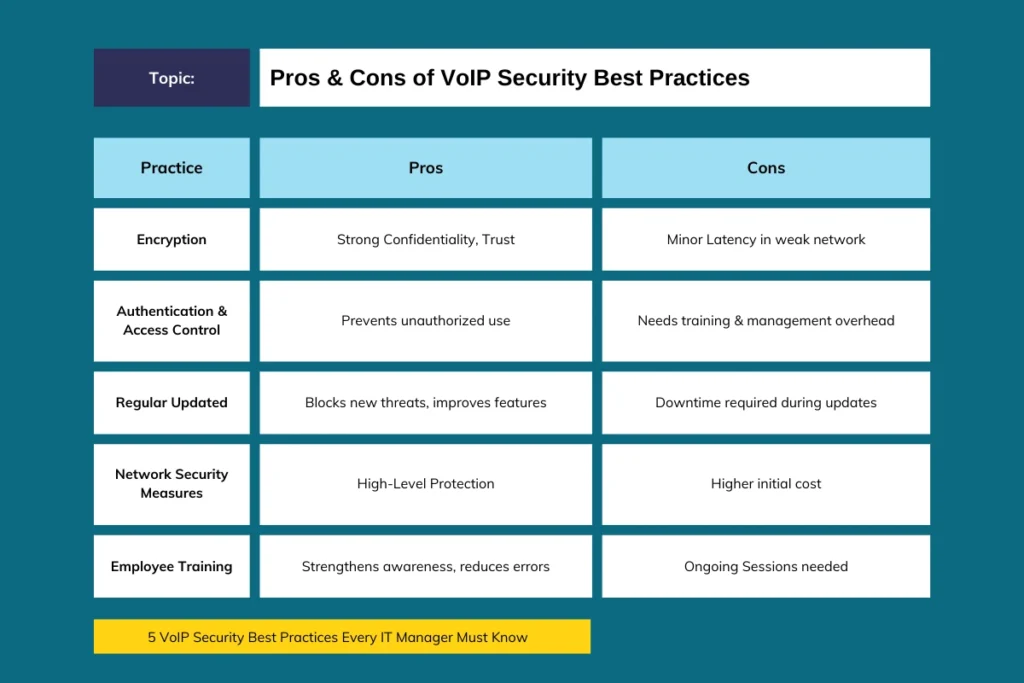Since all types of businesses need clear communication as their crucial key, Voice over Internet Protocol (VoIP) has practically become the backbone of modern business communications. It’s very cost-effective and flexible in use, and feature-rich, making it a preferred choice for a long time over traditional types of phones and landlines. But with these benefits come a few risks too, like VOIP systems are main targets for cyberattacks such as eavesdropping, phishing, toll fraud, and distributed denial of services (DDoS).
That’s why VOIP security best practices are crucial for IT managers in 2025. Whether you are running a small office system or a large enterprise network, security gaps can expose sensitive data and interrupt operations. To build a safer and more reliable setup, many organizations trust Spoglink – a trusted online store for VoIP solutions for their communication needs.
This guide mainly focuses on exploring five VOIP security best practices with insights from Cisco, NIST, and enterprise-level strategies to keep your communication system secure.
Why VoIP Security Matters
Before diving into solutions, IT managers must understand the risks:
- Call Interception – Hackers can listen to confidential calls.
- VoIP Phishing (Vishing) – Fake calls used to trick employees.
- Fraudulent Usage – Criminals manipulate systems to make international calls.
- DDoS Attacks – Overwhelming servers to disrupt service.
- Data Theft – VoIP systems carry personal and financial data.
Without a VoIP security checklist, businesses risk downtime, compliance issues, and reputational damage.
5 VoIP Security Best Practices (2025 Checklist)
1. Encrypt All VoIP Communication
VoIP data travels over the internet, making encryption non-negotiable. Using Secure Real-time Transport Protocol (SRTP) guarantees voice packets are protected against interception.
- Cisco VoIP security best practices highlight Transport Layer Security (TLS) alongside SRTP.
- For enterprises, VoIP security best practices, NIST recommends using end-to-end encryption for call signaling and media.
Pros:
Protects confidentiality, builds customer trust
Cons:
May add slight latency on low-bandwidth networks
2. Implement Strong Authentication & Access Controls
Weak passwords and unrestricted access are gateways for hackers. IT managers should:
- Use multi-factor authentication (MFA).
- Enforce complex password policies.
- Restrict VoIP system access to authorized personnel.
A proper enterprise VoIP security best practices checklist includes Role-Based Access Control (RBAC), ensuring only the right users have access to administrative features.
Pros:
Prevents unauthorized access, easy to scale
Cons:
Requires regular employee training
3. Regularly Update Firmware & Security Patches
Outdated VoIP systems are vulnerable. Whether it’s a Cisco IP phone or a Yealink device, consistent updates are vital.
- Apply firmware patches as soon as they’re released.
- Enable automatic updates when possible.
- Monitor vendor advisories for vulnerabilities.
This improves not just security but also quality, compatibility, and performance.
Pros:
Protects from new threats, improves device performance
Cons:
Requires downtime during updates.
4. Secure Your VoIP Network Infrastructure
VoIP is only as secure as the network it runs on. Best practices include:
- Deploy firewalls and Session Border Controllers (SBCs).
- Segment VoIP traffic from general internet traffic.
- Use Virtual LANs (VLANs) for call traffic.
- Monitor with Intrusion Detection/Prevention Systems (IDS/IPS).
Cisco’s enterprise VoIP checklist highlights VLANs and SBCs as must-have layers of defense.
Pros:
Strong network-level protection.
Cons:
Requires investment in hardware/software.
5. Train Employees on VoIP Security Awareness
The human element is often the weakest link. IT managers must:
- Conduct regular VoIP security awareness training.
- Educate staff on vishing scams.
- Share checklists for secure call handling.
Security tools are only effective if employees understand and apply them.
Pros:
Reduces phishing risks, empowers staff
Cons:
Training requires time and consistency
Quick VoIP Security Checklist
| Security Area | Best Practice | Tools/Methods |
| Call Encryption | SRTP, TLS | Cisco, Yealink, NIST |
| Authentication | MFA, RBAC | Enterprise VoIP setups |
| Updates & Patching | Regular firmware updates | Vendor advisories |
| Network Protection | VLANs, SBCs, IDS/IPS | Cisco infrastructure |
| Employee Training | Vishing awareness, password rules | Training workshops |
Compatibility & Integration Factors
When implementing VoIP security:
- Compatibility – Ensure your chosen devices (e.g., Spoglink VoIP phones) support encryption and VLAN integration.
- Quality – Security shouldn’t compromise call clarity. Use devices optimized for secure protocols.
- Display & Management – IP phones with easy-to-navigate interfaces simplify monitoring and troubleshooting.
For product category and details, check Spoglink’s homepage for enterprise-ready VoIP devices that meet these requirements.
Trends in VoIP Security (2025 & Beyond)
The future of VoIP security is proactive defense. Some trends IT managers should watch:
- AI-driven intrusion detection – AI systems automatically block suspicious activity.
- Zero Trust architecture – No device or user is trusted by default.
- Cloud-based VoIP security tools – Centralized, scalable protection for remote teams.
By adopting these, IT managers can stay ahead of evolving cyber threats.
Pros & Cons of VoIP Security Best Practices

End Conclusion
VoIP phones are known as the backbone of the business’s communications, but without security, it is a liability. By following these VoIP security practices, IT managers can protect their systems from data breaches, fraud, and downtime.
Starting from encryption and authentication to employee training and network hardening, each step plays a very crucial role in a secure communication strategy. Whether you’re implementing Cisco VoIP security best practices, aligning with NIST recommendations, or setting up an enterprise VoIP system, these measures are essential in 2025.

Spoglink: Where Smart Buyers Go for Smarter Gear
Join thousands who rely on us for quality, performance, and real support.





